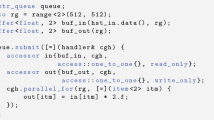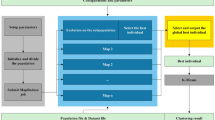Abstract
Particle collision detection is important for diverse simulating systems that involve spatial interactions between particles. Traditional parallelization strategy, which equally partitions the domain, can lead to skewed load distributions if the particles are not uniformly distributed. Moreover, the communication cost is relatively high when it comes to multilayer collision detection method. To solve this problem and to improve the parallel efficiency, this paper proposes an estimation-based domain decomposition method (ED-method) and an estimation-based multilayer method (EM-method) for homogeneous processors. Based on the performance estimation, the tasks are reassigned when it is necessary to balance the workload among different homogeneous processes. In the experiments, we compare these methods under different simulation conditions. Compared with the traditional method, the proposed method achieves better load balancing by taking advantage of features of the multilayer collision detection, and the results prove the excellence of the proposed method.





Similar content being viewed by others
References
Allen, M.P.: Computer Simulation of Liquids. Clarendon Press, New York (1989)
Bonet, J., Peraire, J.: An alternating digital tree (ADT) algorithm for 3D geometric searching and intersection problems. Int. J. Numer. Methods Eng. 31(1), 1–17 (1991)
Ericson, C.: Real-time Collision Detection. CRC Press, Boca Raton (2004)
Feng, Y.T., Owen, D.R.J.: An augmented spatial digital tree algorithm for contact detection in computational mechanics. Int. J. Numer. Methods Eng. 55(2), 159–176 (2002)
Fernandes, D.T., Cheng, L.Y., Favero, E.H., Nishimoto, K.: A domain decomposition strategy for hybrid parallelization of moving particle semi-implicit MPS method for computer cluster. Cluster Comput. 18(4), 1363–1377 (2015)
Gingold, R.A., Monaghan, J.J.: Smoothed particle hydrodynamics: theory and application to non-spherical stars. Mon. Not. R. Astron. Soc. 181(3), 375–389 (1977)
Gundall, P.A., Strack, O.D.L.: A discrete numerical model for granular assemblies. Géotechnique 29(1), 47–65 (1979)
He, K., Dong, S., Zhou, Z.: Multigrid contact detection method. Phys. Rev. E. 75(3), 036710 (2007). doi:10.1103/PhysRevE.75.036710
Kačianauskas, R., Maknickas, A., Kačeniauskas, A., Markauskas, D., Balevičius, R.: Parallel discrete element simulation of poly-dispersed granular material. Adv. Eng. Softw. 41(1), 52–63 (2010)
Maknickas, A., Kačeniauskas, A., Kačianauskas, R., Balevičius, R., Džiugys, A.: Parallel DEM software for simulation of granular media. Informatica 17(2), 207–224 (2006)
Markauskas, D., Kačeniauskas, A.: The comparison of two domain repartitioning methods used for parallel discrete element computations of the hopper discharge. Adv. Eng. Softw. 84(C), 68–76 (2015)
Mathias, E., Gu, L.: Hierarchical spatial hashing for real-time collision detection. In: Proceedings of the IEEE International Conference on Shape Modeling and Applications 2007, pp. 61–70. IEEE Computer Society (2007)
Mazhar, H., Heyn, T., Negrut, D.: A scalable parallel method for large collision detection problems. Multibody Syst. Dynamics 26(1), 37–55 (2011)
Mio, H., Shimosaka, A., Shirakawa, Y., Hidaka, J.: Optimum cell condition for contact detection having a large particle size ratio in the discrete element method. J. Chem. Eng. Jpn. 39(4), 409–416 (2006)
Moon, B., Saltz, J.: Adaptive runtime support for direct simulation Monte Carlo methods on distributed memory architectures. In: Proceedings of the Scalable High-Performance Computing Conference 1994, pp. 176–183. IEEE (1994)
Munjiza, A.A., Knight, E.E.: Computational Mechanics of Discontinua. Wiley, Chichester (2011)
Ogarko, V., Luding, S.: A fast multilevel algorithm for contact detection of arbitrarily polydisperse objects. Comput. Phys. Commun. 183(4), 931–936 (2012)
Park, S.W., Jun, C.W., Sohn, J.H., Lee, J.W.: Comparison of GPU-based numerous particles simulation and experiment. Trans. Korean Soc. Mech. Eng. A 38(7), 751–756 (2014)
Peters, J.F., Kala, R., Maier, R.S.: A hierarchical search algorithm for discrete element method of greatly differing particle sizes. Eng. Comput. 26(6), 621–634 (2009)
Rapaport, D.C.: The Art of Molecular Dynamics Simulation. Cambridge University Press, New York (2004)
Träff, J.L., Gropp, W.D., Thakur, R.: Self-consistent MPI performance guidelines. IEEE Trans. Parallel Distrib. Syst. 21(5), 698–709 (2010)
Walther, J.H., Sbalzarini, I.F.: Large-scale parallel discrete element simulations of granular flow. Eng. Comput. 26(6), 688–697 (2009)
Williams, J.R., O’Connor, R.: Discrete element simulation and the contact problem. Arch. Comput. Methods Eng. 6(4), 279–304 (1999)
Zheng, J., An, X., Huang, M.: GPU-based parallel algorithm for particle contact detection and its application in self-compacting concrete flow simulations. Comput. Struct. 112, 193–204 (2012)
Acknowledgements
This work was supported by the National Natural Science Foundation of China (NSFC) (No. 61272200, 10805019), the Program for Excellent Young Teachers in Higher Education of Guangdong, China (No. Yq2013012), the Fundamental Research Funds for the Central Universities (2015ZJ010), the Special Support Program of Guangdong Province (201528004), and the Pearl River Science & Technology Star Project (201610010046).
Author information
Authors and Affiliations
Corresponding author
Rights and permissions
About this article
Cite this article
Chen, S., He, K., You, L. et al. Parallel multilayer particle collision detection method based on performance estimation. Cluster Comput 21, 1301–1309 (2018). https://doi.org/10.1007/s10586-017-1141-8
Received:
Revised:
Accepted:
Published:
Issue Date:
DOI: https://doi.org/10.1007/s10586-017-1141-8




